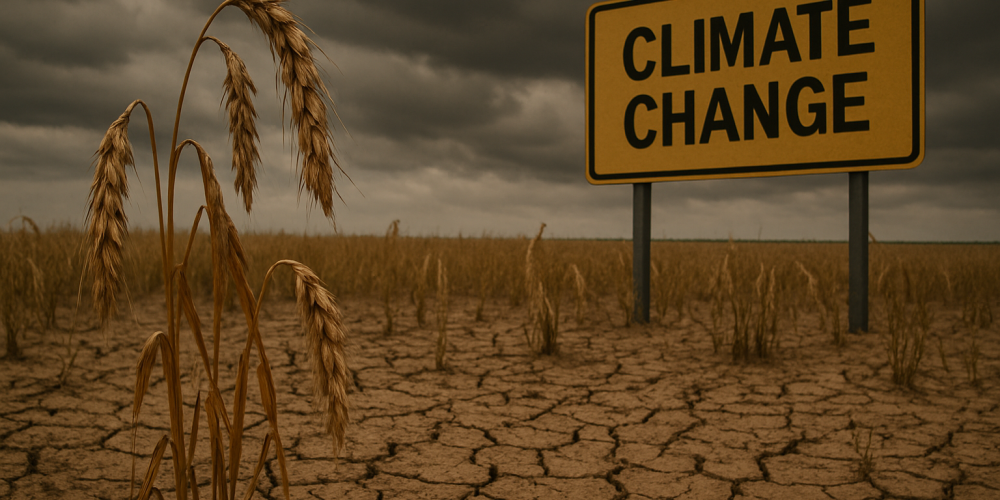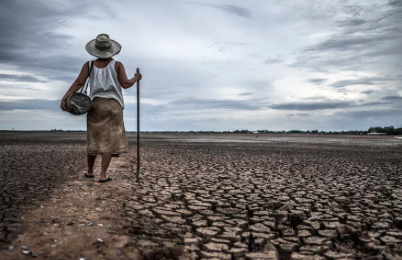Introduction

Climate change severely impacts wheat, which is the principal staple crop in Pakistan, forming the foundation of food security for millions of people. It contributes more than 72% of the daily caloric intake and contributes around 1.7% to the GDP while accounting for approximately 9% of value addition in agriculture (Hussain et al., 2020). Punjab is significant in terms of Pakistan’s wheat production, contributing nearly 70% of the total national output. However, in recent years, wheat production has been facing severe challenges due to climate change, which has resulted in increasing temperatures, changing rainfall patterns, and extreme weather events, all of which have negatively affected wheat productivity.
These climate-induced factors have led to declining yields, food insecurity, and economic difficulties for farmers. Given that a majority of Pakistan’s population relies on wheat as their primary source of sustenance, any decline in wheat production poses a serious threat to food availability and national stability.
Declining Wheat Yields in Pakistan – Climate Change
In the province of Punjab, there is a worrying trend of declining yields and fluctuating output. Over the past decade, wheat production in the region has ranged between 18 to 26 million tons per annum, with a declining trend in recent years due to climate change. The province of Punjab accounts for approximately 70% of Pakistan’s total wheat output, yet in the last five years, its total wheat production has decreased by nearly 4.5% (Hussain et al., 2020).
This decline has been largely attributed to climate change, which has led to increasing temperatures, unexpected shifts in rainfall patterns, and rising water scarcity. The Pakistan Bureau of Statistics (PBS) reports that around 40% of agricultural land in the region has been affected by soil degradation, reducing its productivity. Additionally, excessive reliance on groundwater for irrigation has led to a significant depletion of underground water reserves, making it increasingly difficult for farmers to maintain optimal wheat yields (Abbas et al., 2022).
Impact of Rising Temperatures (Climate Change) on Wheat Production
The climate changes of temperature fluctuations have had one of the most significant impacts on wheat production. As a temperature-sensitive crop, wheat has a narrow optimal growing range, with ideal temperatures ranging between 15–25°C. However, due to global warming, temperatures in the province have been increasing at an alarming rate (climate change). Studies show that average temperatures have risen by approximately 0.5°C per decade, with a 1.5°C increase recorded over the last three decades (Ali et al., 2022) leading to climate change.
This increase has led to a reduction in the wheat growing period by about 15 days, particularly affecting the grain-filling stage. High temperatures during this critical period lead to reduced grain size, which significantly lowers overall yields (Hussain et al., 2020). If the current warming trend continues, researchers predict that wheat production in the province could decline by 20-30% by 2050 (Ali et al., 2022).
Erratic Rainfall Patterns (Climate Change) and Their Effects
Another major challenge faced by wheat farmers in the province is erratic and shifting rainfall patterns. The winter rains, which are crucial for wheat growth, have become more unpredictable in recent years, leading to difficulties in determining the optimal sowing and irrigation schedules (Abbas et al., 2022). Delayed winter rainfall has often resulted in drought-like conditions during the early growing phase, reducing soil moisture and inhibiting proper plant growth.
Conversely, sudden heavy rainfall at critical stages has caused waterlogging, root rot, and the spread of fungal diseases such as wheat rust and smut (Hussain et al., 2020). The frequency of droughts in Punjab, for instance, has increased by nearly 40% over the past decade (Ali et al., 2022). This has led to reduced water availability in the Rabi season, negatively affecting wheat germination and early growth. In certain years, particularly 2022 and 2023, severe monsoon rains and unexpected spring rainfall have also damaged wheat crops just before harvesting, causing significant economic losses to farmers.
Extreme Weather Events (Climate Change) and Crop Damage

Alongside temperature rise and changing rainfall patterns, extreme weather events have increased in frequency and intensity. The province has experienced more frequent heatwaves, unseasonal frost, and hailstorms, all of which have devastated wheat fields at various growth stages. In April 2022, a heatwave led to a severe reduction in wheat grain weight, cutting overall production by nearly 10-12% (Ali et al., 2022).
Similarly, heavy hailstorms in early 2023 flattened thousands of acres of wheat, leading to an estimated 15% loss in yield in some districts (Pakistan Meteorological Department, 2023). These extreme events not only reduce wheat production but also contribute to post-harvest losses due to broken stems and damaged grains, reducing both the quantity and quality of wheat available for consumption.
Pests, Diseases, and Climate-Induced Crop Threats
Rising temperatures and increased humidity have also created favorable conditions for pests and diseases, further harming wheat production. The proliferation of wheat rust, aphids, and fungal diseases has resulted in significant yield losses, particularly in districts with high humidity levels (Azmat et al., 2021). Recent research suggests that wheat rust, a devastating fungal disease, has become more prevalent due to changing weather patterns. Between 2018 and 2023, several major wheat-growing districts in the province suffered from severe rust outbreaks, leading to production losses of up to 20% (Hussain et al., 2020). The prevalence of these diseases has increased the reliance on chemical pesticides, which in turn raises production costs for farmers and poses risks to soil health.
Soil Degradation and Its Consequences for Wheat Farming

Another pressing challenge faced by wheat farmers is the degradation of soil quality due to climate-related factors. Soil fertility is deteriorating because of rising temperatures, erratic rainfall, and excessive use of chemical fertilizers and pesticides. The increased frequency of extreme weather events, particularly droughts and floods, has led to soil erosion, depleting essential nutrients necessary for wheat growth (Azmat et al., 2021). Over the past two decades, soil organic matter content in the province has declined significantly, reducing its capacity to retain moisture and sustain crop productivity.
Water shortages, coupled with increased reliance on tube wells, have also led to soil salinization, particularly in the arid and semi-arid zones (Ali et al., 2022). A survey by the Pakistan Agricultural Research Council (PARC) revealed that nearly 6.3 million hectares of land in Punjab are affected by salinity, which drastically reduces wheat yields. Farmers often use excessive chemical fertilizers to counter declining soil fertility, but this results in further soil degradation over time. If soil health continues to decline at this rate, it could further accelerate the province’s wheat production crisis in the coming decades (Hussain et al., 2020).
Addressing these challenges requires a multi-pronged approach that involves sustainable agricultural practices, improved irrigation infrastructure, and enhanced climate resilience programs. The promotion of organic farming, crop rotation, and the use of biofertilizers can help restore soil fertility and improve wheat yields. Additionally, investments in water conservation technologies, such as rainwater harvesting and efficient irrigation systems, are essential to combat water shortages (Abbas et al., 2022).
Government initiatives should focus on providing financial assistance, subsidies, and climate insurance programs for farmers to help them mitigate the financial risks associated with extreme climate conditions. Unless urgent measures are taken, wheat production will continue to suffer, exacerbating food insecurity and increasing economic vulnerabilities for millions in Punjab.
Economic Challenges and Crop Shifts
Economic instability has further worsened the impact of climate change on wheat production. Declining wheat yields have led to financial strain on farmers, many of whom are small-scale cultivators relying on their harvests for both food and income. Due to rising production costs and erratic weather conditions, many farmers have begun shifting to other crops such as maize and sugarcane, which are considered more drought-resistant and economically viable (Abbas et al., 2022).
This shift, however, exacerbates the problem of wheat shortages, leading to higher wheat prices and greater food insecurity. The price of wheat flour has risen by 35% in the last two years, making it increasingly unaffordable for lower-income households (Ali et al., 2022). The situation has also led to a surge in wheat imports, increasing reliance on foreign markets and contributing to trade deficits.
Climate Adaptation Strategies for Wheat Production
To counteract these challenges and save wheats from climate change, several adaptation strategies are being explored. The development of heat-resistant wheat varieties has been a key focus for researchers. Varieties such as Galaxy-2013 and Ujala-2016 have shown promising results in terms of higher heat and drought tolerance (Azmat et al., 2021). Alongside this, improved irrigation management practices, including drip irrigation and conservation tillage, are being promoted to ensure better water usage efficiency (Hussain et al., 2020).
The government has also introduced subsidy programs and financial support schemes to help small-scale farmers cope with increasing production costs and encourage climate-smart agricultural practices. However, many farmers still lack awareness of climate adaptation techniques and struggle with limited access to modern farming technologies due to high costs and insufficient financial assistance (Abbas et al., 2022). Government should introduce an environment which should be diversified, inclusive, and everyone should be treated equally.
Conclusion
Climate change has significantly affected wheat production in Punjab, primarily through rising temperatures, erratic rainfall, increased droughts, and extreme weather events. These changes have contributed to lower yields, higher production costs, and increased food insecurity. Given that wheat is a staple crop for millions of people in the province, its declining productivity threatens both economic stability and food supply. While various adaptation strategies such as climate-resilient crops, improved irrigation techniques, and government support programs have been introduced, there is still much to be done to ensure a sustainable and climate-resilient wheat sector.
Immediate action is required to support farmers through financial incentives, education on climate-smart agriculture, and investments in water conservation strategies. Without these interventions, wheat production in Punjab will continue to decline, putting greater pressure on food security and the livelihoods of millions.
References
Ø Hussain, J., Khaliq, T., Asseng, S., Saeed, U., Ahmad, A., Ahmad, B., Ahmad, I., Fahad, M., Awais, M., Ullah, A., & Hoogenboom, G. (2020). Climate change impacts and adaptations for wheat employing multiple climate and crop modelsin Pakistan. Climatic Change, 163(1), 253–266. https://doi.org/10.1007/s10584-020-02855-7
Ø Ali, M. A., Hassan, M., Mehmood, M., Kazmi, D. H., Chishtie, F. A., & Shahid, I. (2022). The Potential Impact of Climate Extremes (climate change) on Cotton and Wheat Crops in Southern Punjab, Pakistan. Sustainability, 14(3), 1609. https://doi.org/10.3390/su14031609
Ø Abbas, S., Kousar, S., & Khan, M. S. (2022). The role of climate change in food security; empirical evidence over Punjab regions, Pakistan. Environmental Science and Pollution Research, 29(35), 53718–53736. https://doi.org/10.1007/s11356-022-19315-7
Ø Azmat, M., Ilyas, F., Sarwar, A., Huggel, C., Vaghefi, S. A., Hui, T., Qamar, M. U., Bilal, M., & Ahmed, Z. (2021). Impacts of climate change on wheat phenology and yield in Indus Basin, Pakistan. Science of The Total Environment, 790, 148221. https://doi.org/10.1016/j.scitotenv.2021.148221


